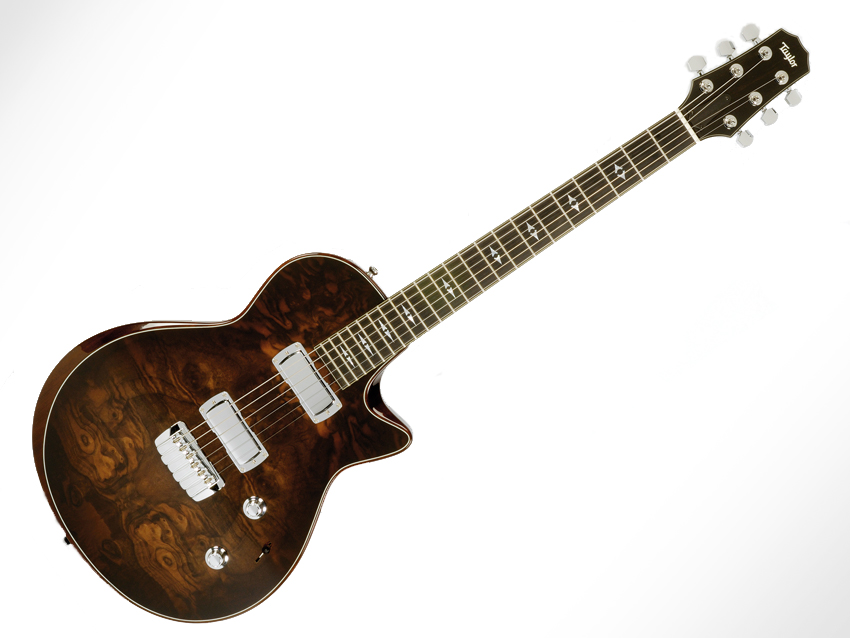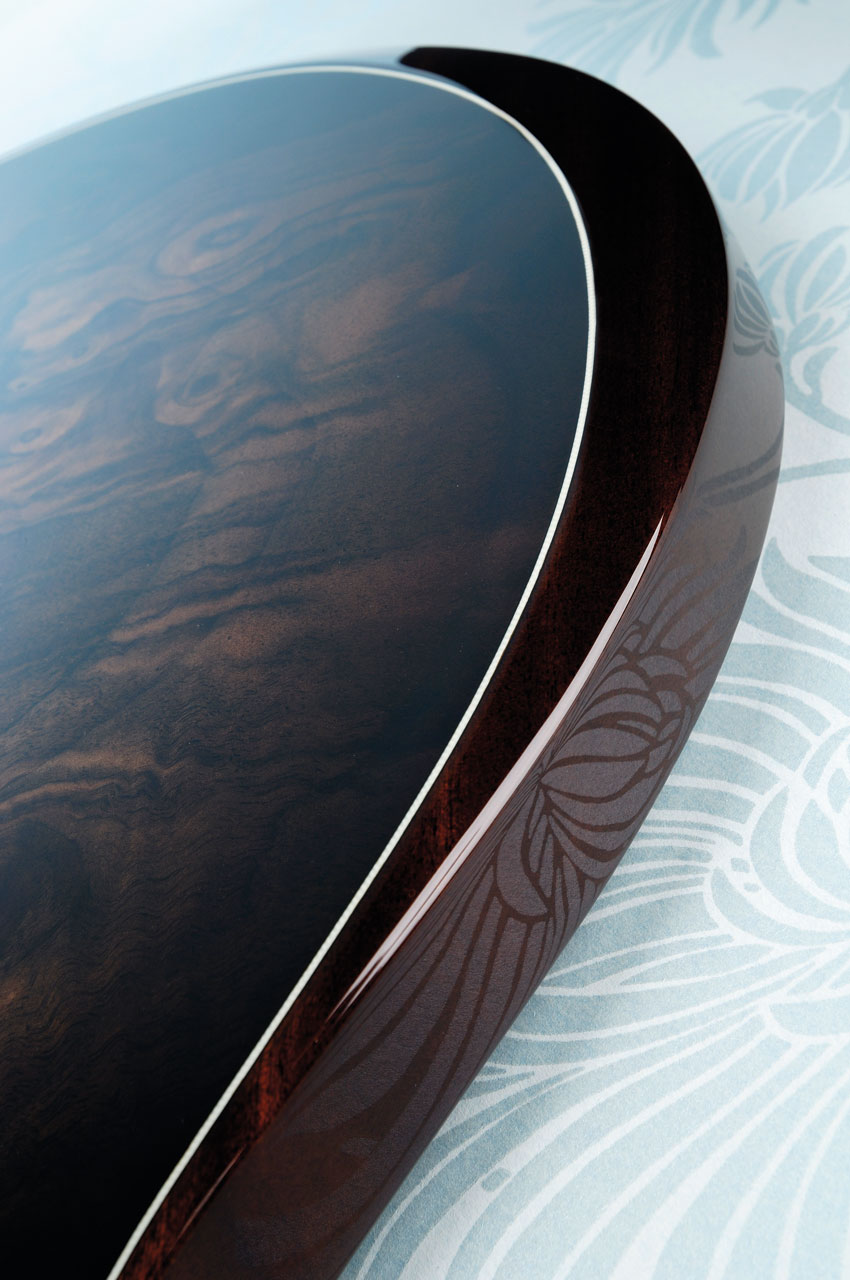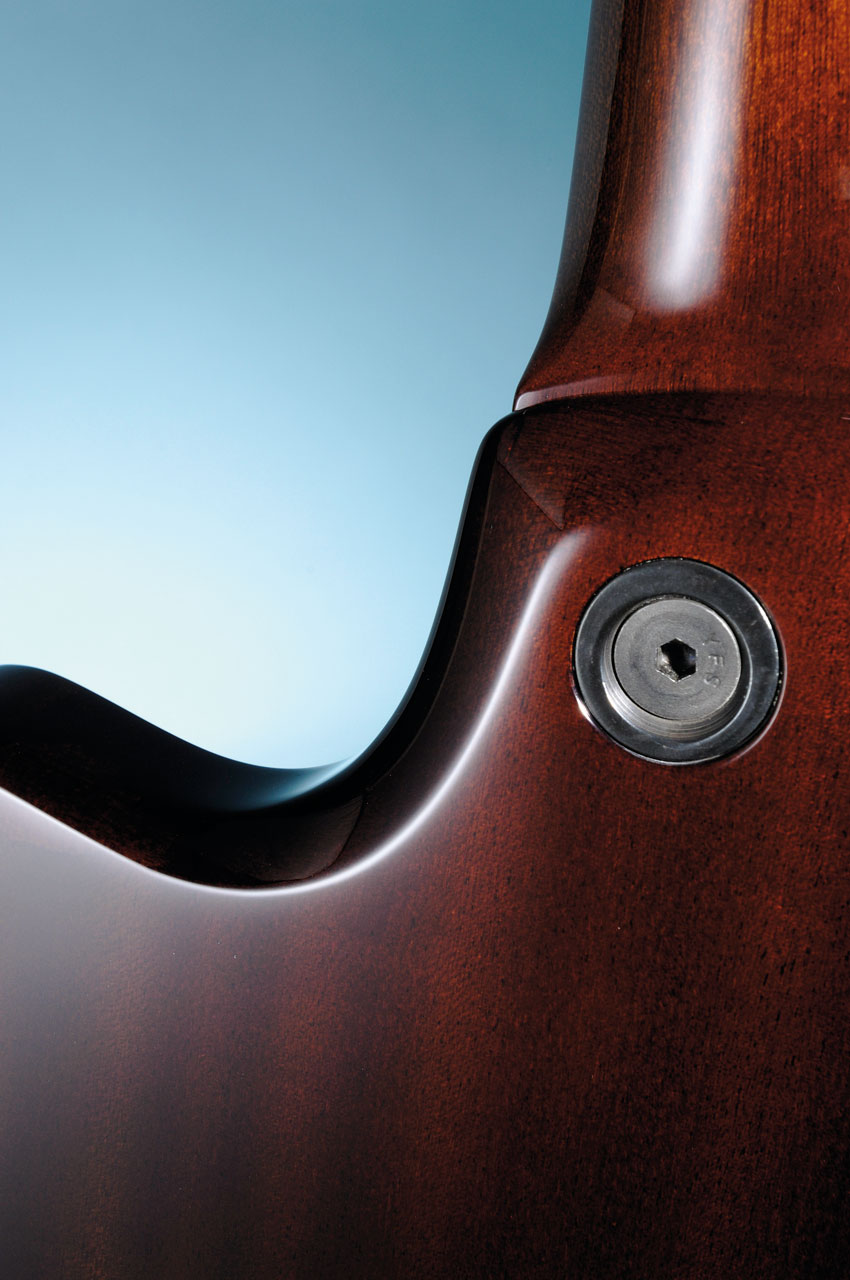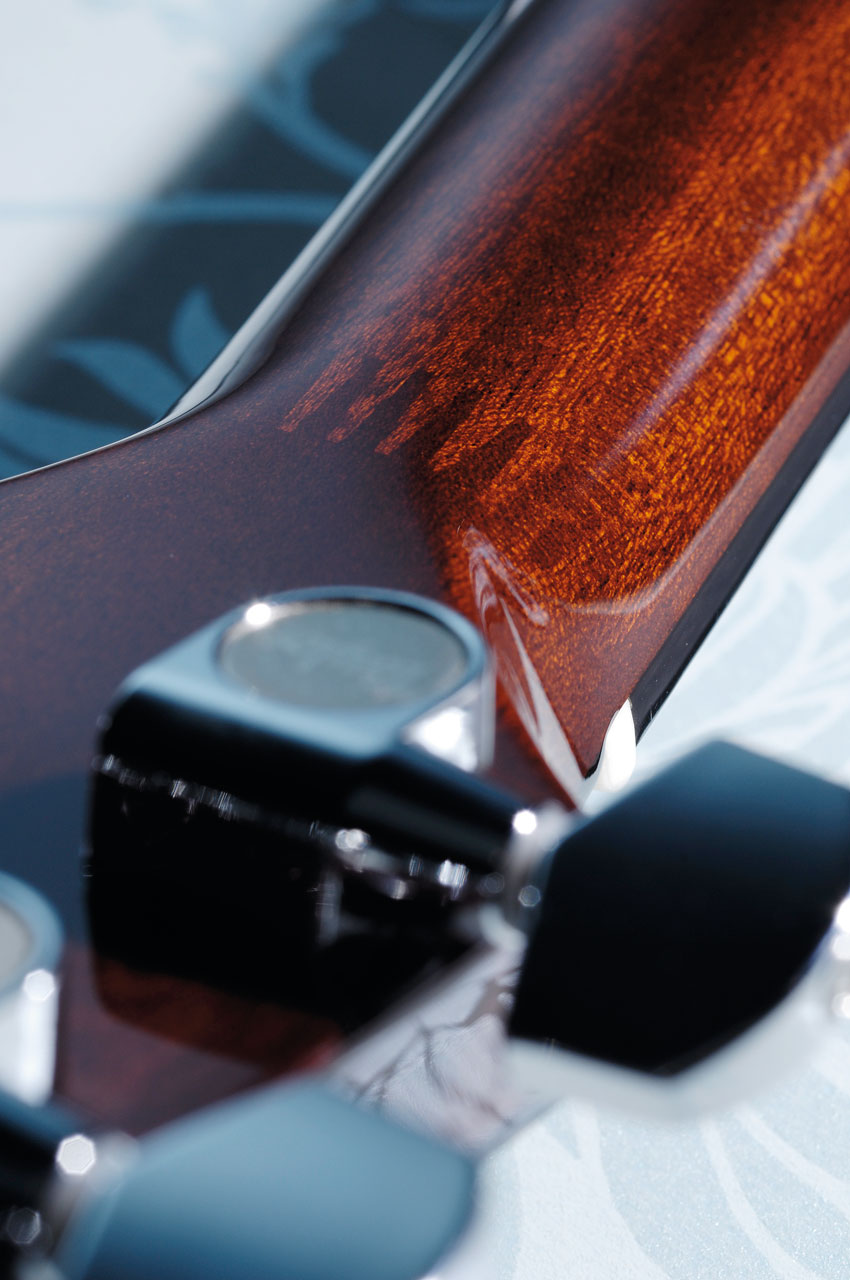MusicRadar Verdict
The Custom is a gorgeous electric guitar with its own sound and character. Despite the modern feel it has boutique appeal, throws in a little hollowbody character and delivers classic chiming and gutsy sounds.
Pros
- +
Innovative construction; unusual walnut burl top; high quality; great sounds.
Cons
- -
Lack of options.
MusicRadar's got your back

Taylor SolidBody Custom



The Custom is the most expensive of Taylor's SolidBody line, and it seems to embody just about everything the series represents.
Design and construction
Appearing to be a sort of downsized Taylor T5 (the famed acoustic/electric hybrid guitar), it's the only one of the line with a rounded (Venetian) cutaway as opposed to the pointed (Florentine) design on the other two models. Taylor is genuinely unsure which it prefers - hence the duality. For the record, here at MusicRadar we prefer the look of the Custom's outline. There are currently no finish or features options for any of the guitars in the series, although some may be introduced in the future.
The body contouring is remarkably complex. The main structure is shaped from three pieces of sapele. It's cut on CNC and internally, heavily chambered - only the area under the pickups and bridge is left solid. The back is curved subtly in both planes and there's a rib-cage contour. The top, a thin, three-piece walnut burl-faced laminate is inset into the main body. There's a contrasting purfling strip around the edge of the top that gives the outline a slightly smaller line and allows a slight chamfer in the cutaway and a larger chamfer for forearm comfort. Again, the top is slightly curved, although it is far from having a traditional arched top.
In playing position the guitar looks much thinner than it is. Maximum depth is approximately 46mm in the body centre although the rim, on the bass side is nearer 30mm. But it's also tapered from bottom to top: 45mm by the bass strap button, around 35mm by the neck joint.
The neck is more standard Taylor fare: one-piece sapele for the main part and the headstock is joined with Taylor's finger-cut joint just visible under the brown colour applied to the neck back, body back and sides. By design it's very similar to the T5's neck, which is pretty similar to Taylor's standard acoustic necks - always renowned for their electric-like playability. The dimensions are quite mainstream (42.8mm at the nut, 53mm at the 12th; in depth we have 20.7mm at the first fret,
22.3mm at the 12th) and the neck- to-body joint, Taylor's T-Lock, is not only tight-fitting but very stable, and all achieved with just a single Allen key bolt.
The fingerboard is ebony and is bound with a black plastic strip and a thin 'micro purfling' contrasting line. The inlays are quite classy, but not overblown, split diamond mother-of-pearl. Fretting is immaculate from a medium wire. The radius, for an electric, is quite flat at Taylor's standard 15inches (381mm); more classic brands use a smaller. More contemporary brands do use a flatter radius, so it certainly gives the Custom a more modern and less vintage feel.
Want all the hottest music and gear news, reviews, deals, features and more, direct to your inbox? Sign up here.
The scale length is 632mm (24.9inch), the same as the T5, a little longer than Gibson's nominal 628mm (24.75inch). The neck profile is again typically mainstream and very Taylor: a medium 'C' profile.
The back-angled headstock also sticks with safe Taylor territory. Here it's ebony faced with the same binding/purfling as the fingerboard. Only the rather generic-looking, big button tuners let it down. They feel a little spongy in use, although we rarely used them; this is one very stable guitar.
Hardware and electrics
At the other end of the string is a fantastic new Taylor bridge design, machined from acoustically resonant aluminium and all curved and contoured for a very sleek feel. The strings 'top mount' into the back of the individual 'shuttles' and emerge over a precise, lip-like break point. Individual intonation can be set via a small Allen key bolt just by the string anchor point, and the important thing is that the whole saddle moves, ensuring the same distance from anchor to break point wherever it's set. There is no individual height adjustment and the curve of the saddles is set at 12inches - the same geometry as on all Taylor guitars.
There are no visible screws. The bridge is actually inset into the top and held in place by a rear mounted metal plate that you can see, along with the height adjustment bolts, when you remove the back plate. This fixing firmly clamps the bridge to the body wood for, Taylor believes, maximum vibrational transfer.
If the bridge design was a serious job, the pickups - again developed by Taylor - were equally time intensive and apparently the start-point of the whole electric project. On the Custom these are Style 1 humbuckers with their mini humbucking-like chromed covers. They sit in chromed metal rings, with no polepiece adjustment, just standard height adjustment. Under the covers, however, we have what look like dual-rail single-coil-sized humbuckers. They pass to a five-way lever switch that gives us, according to Taylor's David Hosler: "Position one, full neck pickup; position two is the inside coils of both pickups in parallel - we have a north and a south polarity so we're still humbucking. Position three is full neck pickup and one coil of the bridge pickup. Position four is the two inside coils again but now in series and position five is the bridge humbucker. The least humbucking is position three."
The control knobs, again chromed metal, mirror the vibe of the bridge design and even the side-mounted output jack is placed on an American-football shaped chromed metal plate. Removing the second back plate reveals some very tidy electronics; the five-way switch is mounted on a metal plate and connects to a small PCB, which also holds the plug-in connectors for the pickups. There's a small five-milliamp fuse clearly visible too, which Taylor say "will fry instead of you" if you fall foul of dodgy or unearthed wiring. If the fuse goes, the guitar will still play, but may be a little noisy.
Sounds
The Custom's tone has a slightly hollow characteristic yet there's focus to the sound and perhaps, of the three guitars in the series, this is the most definitive Taylor SolidBody sound.
If you're expecting big Gibson Les Paul/PRS Singlecut performance you'll be disappointed; it's not that the Custom can't produce rich bass response, typical of a single-cutaway guitar, but it also applies a slightly brighter and bell-like 'Fender' characteristic, again with that touch of hollowbody. Depending on your amp tone, the single-coil combinations sound quite Grestch-like and fifties.
That said, we wouldn't want you to think the Custom isn't capable of some raw rock-out voices, because it is. Up the gain and there's a tough abrasive character from the bridge pickup although we expected a little more width from the neck pickup.
See and hear the SolidBody Custom in action:
MusicRadar is the number one website for music-makers of all kinds, be they guitarists, drummers, keyboard players, DJs or producers...
- GEAR: We help musicians find the best gear with top-ranking gear round-ups and high-quality, authoritative reviews by a wide team of highly experienced experts.
- TIPS: We also provide tuition, from bite-sized tips to advanced work-outs and guidance from recognised musicians and stars.
- STARS: We talk to musicians and stars about their creative processes, and the nuts and bolts of their gear and technique. We give fans an insight into the craft of music-making that no other music website can.
